Abstract
The gene for autosomal dominant polycystic kidney disease (PKD1) is located on chromosome 16p, between the flanking markers D16S84 and D16S125 (26.6prox). This region is 750 kb long and has been cloned. We have looked at the association of 10 polymorphic markers from the region, with the disease and with each other. This was done in a set of Scottish families that had previously shown association with D16S94, a marker proximal to the PKD1 region. We report significant association between two CA repeat markers and the disease but have not found evidence for a single founder haplotype in these families, indicating the presence of several mutations in this population. Our results favor a location of the PKD1 gene in the proximal part of the candidate region.
Full text
PDF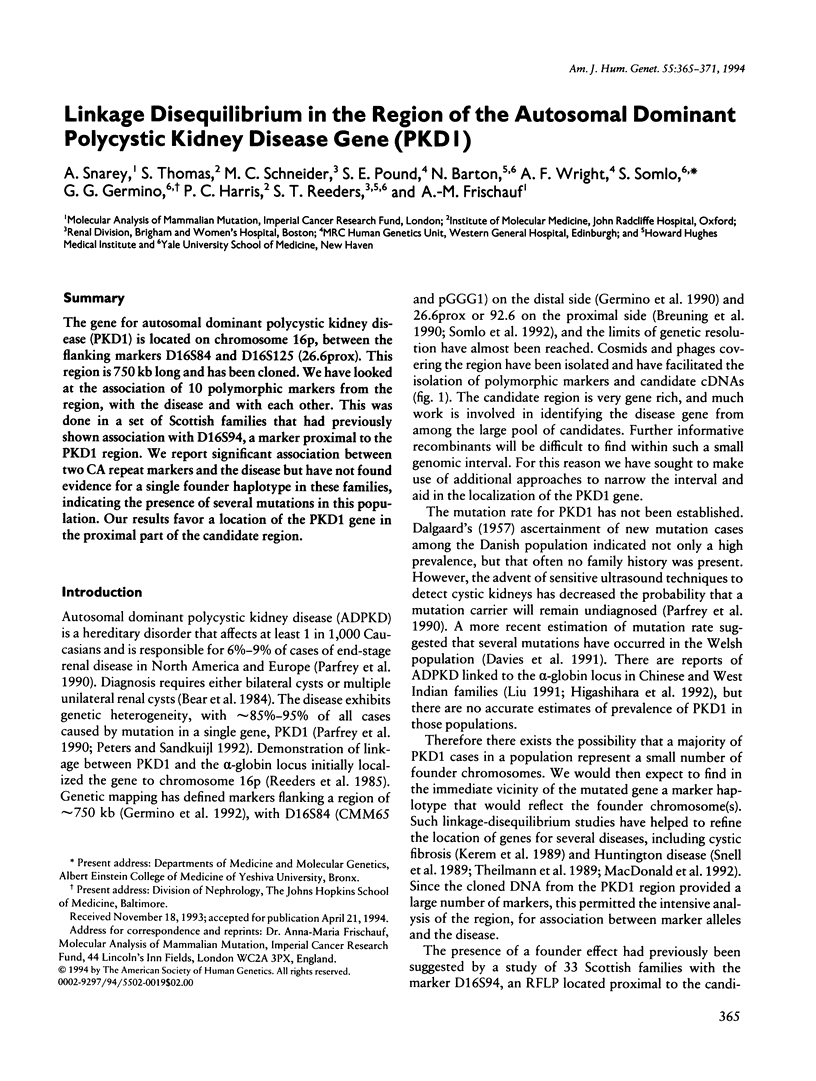
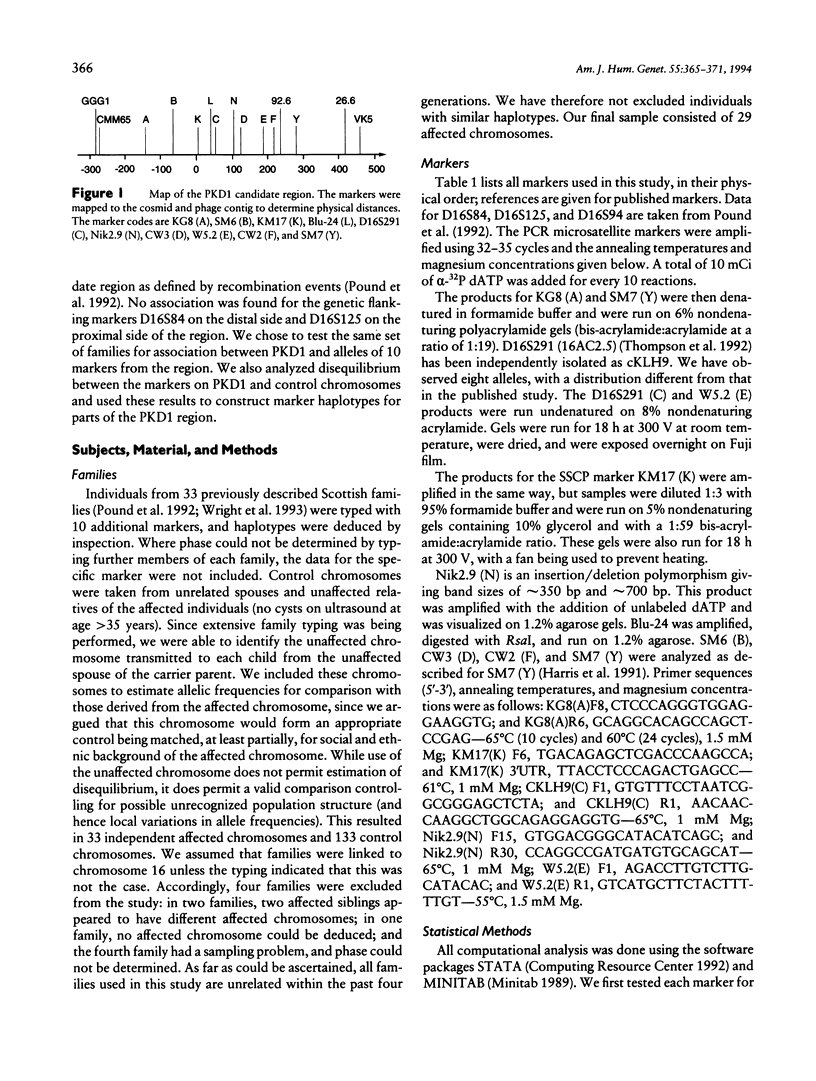
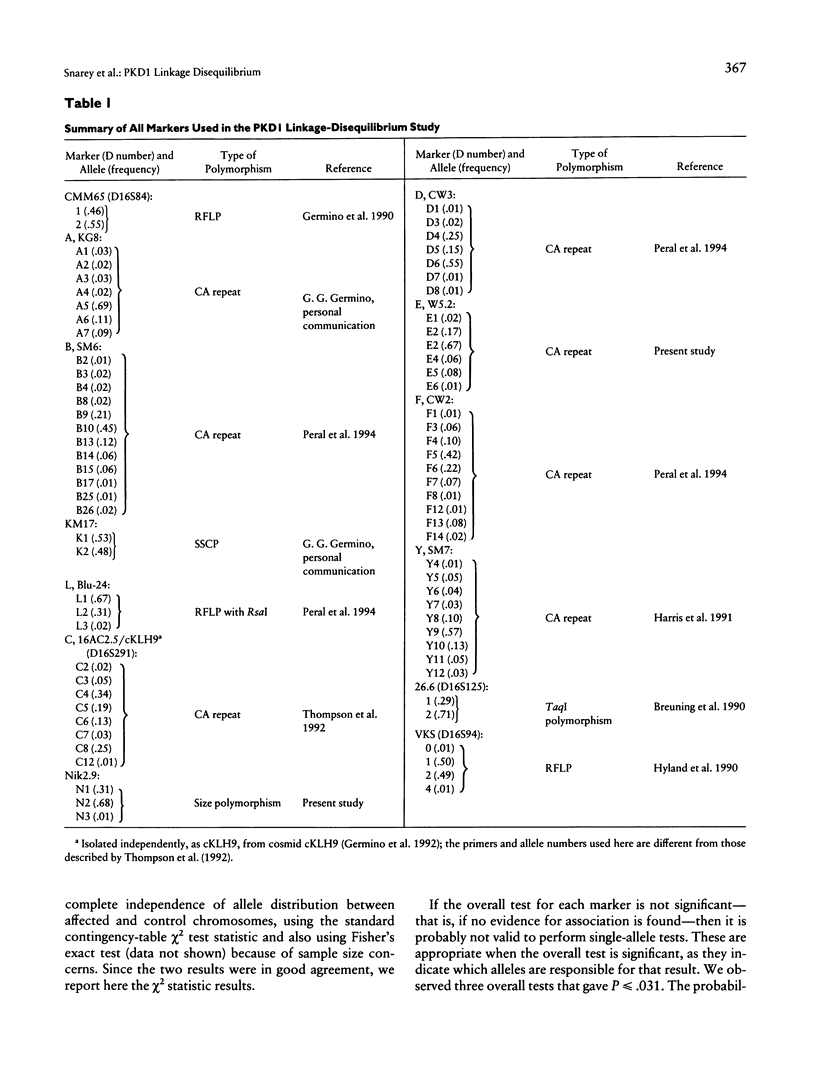
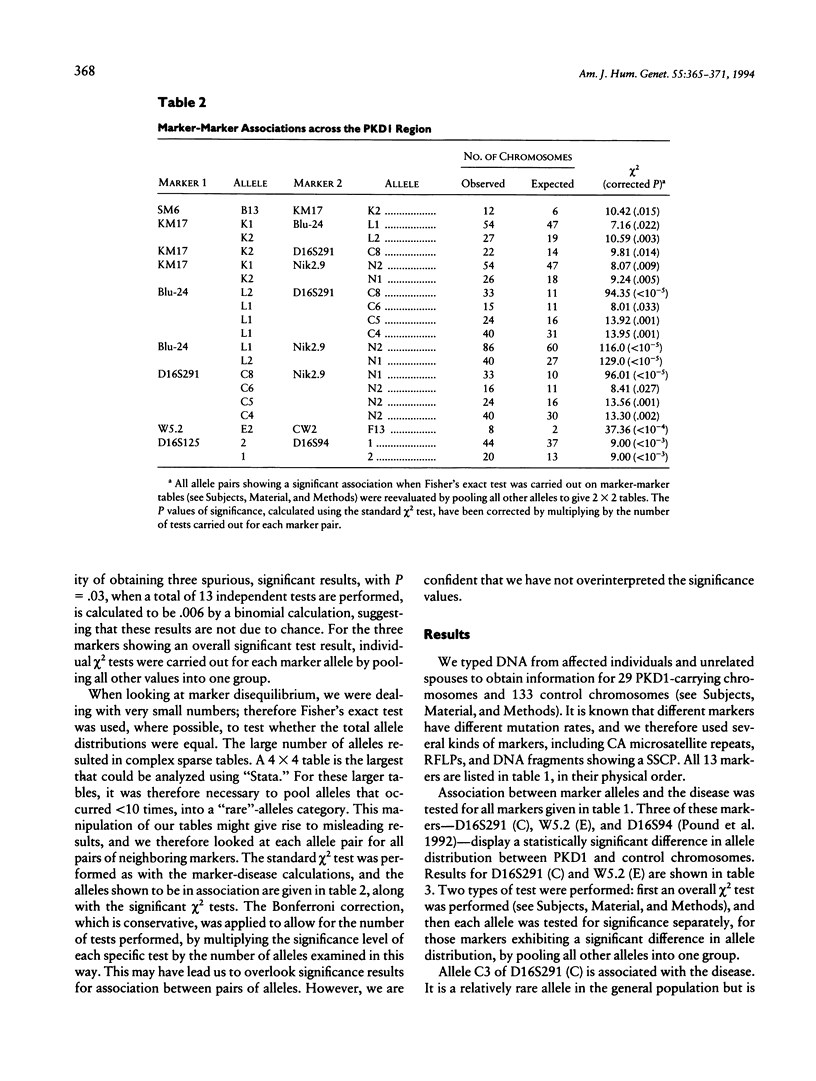
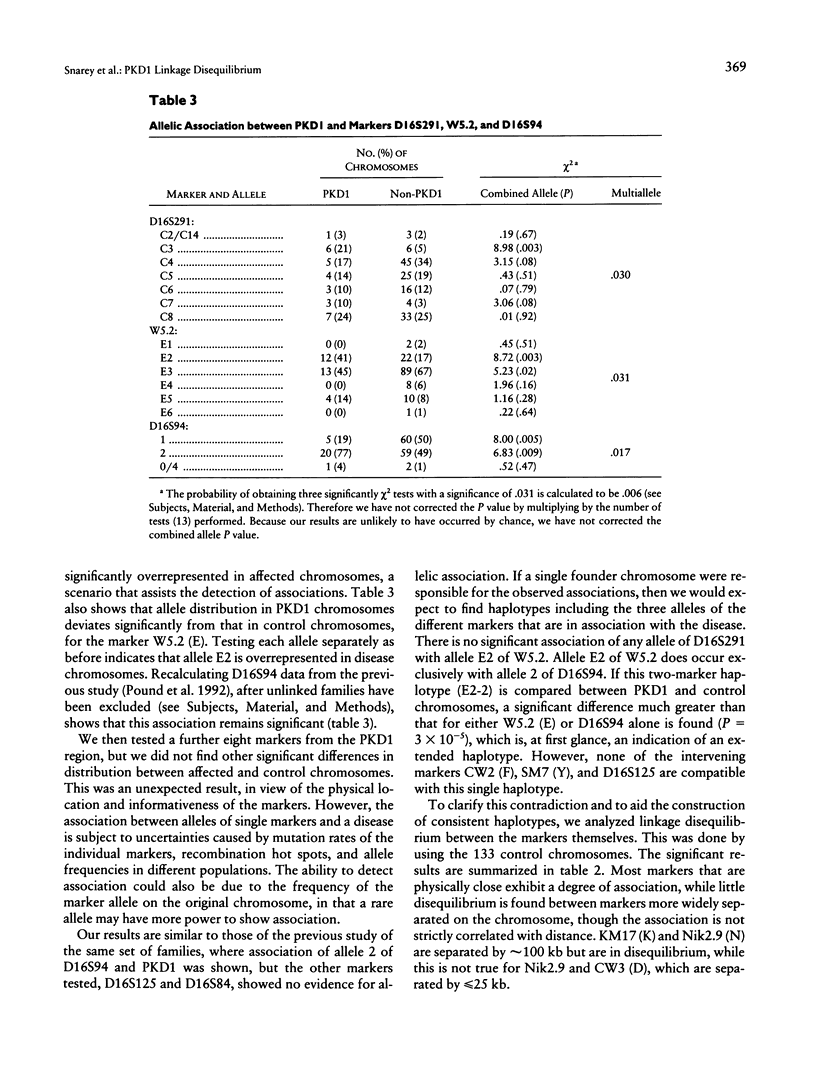
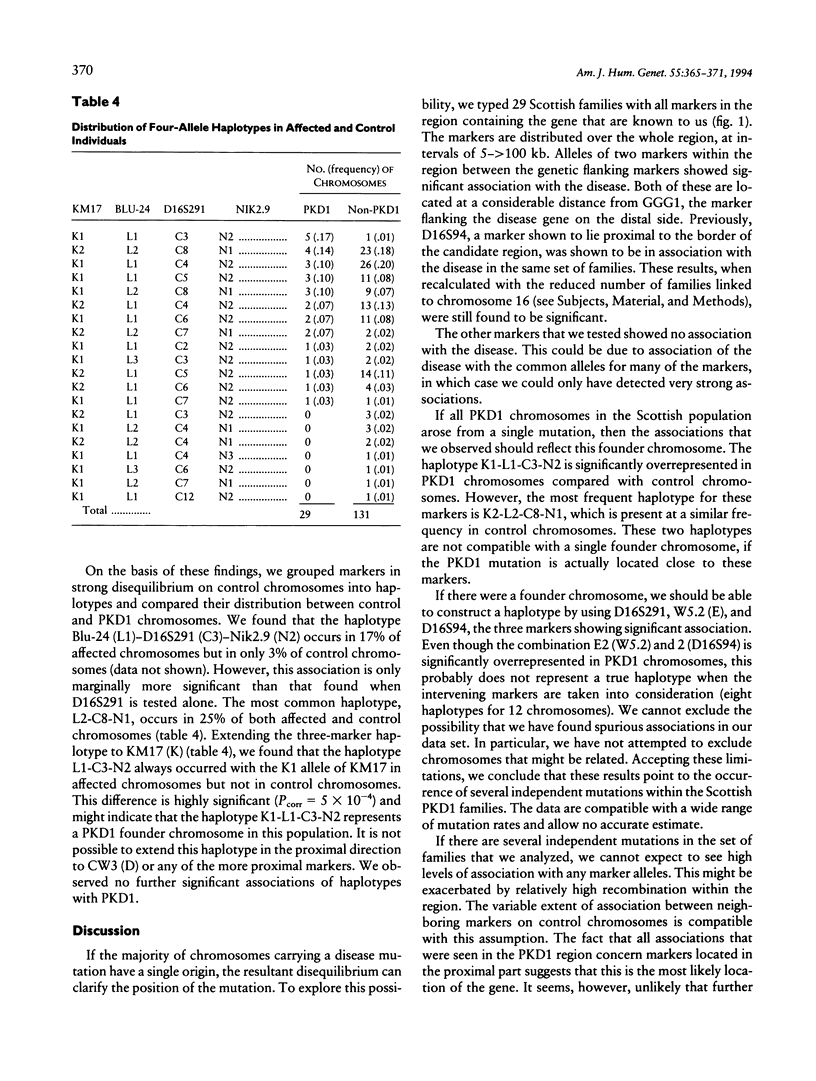
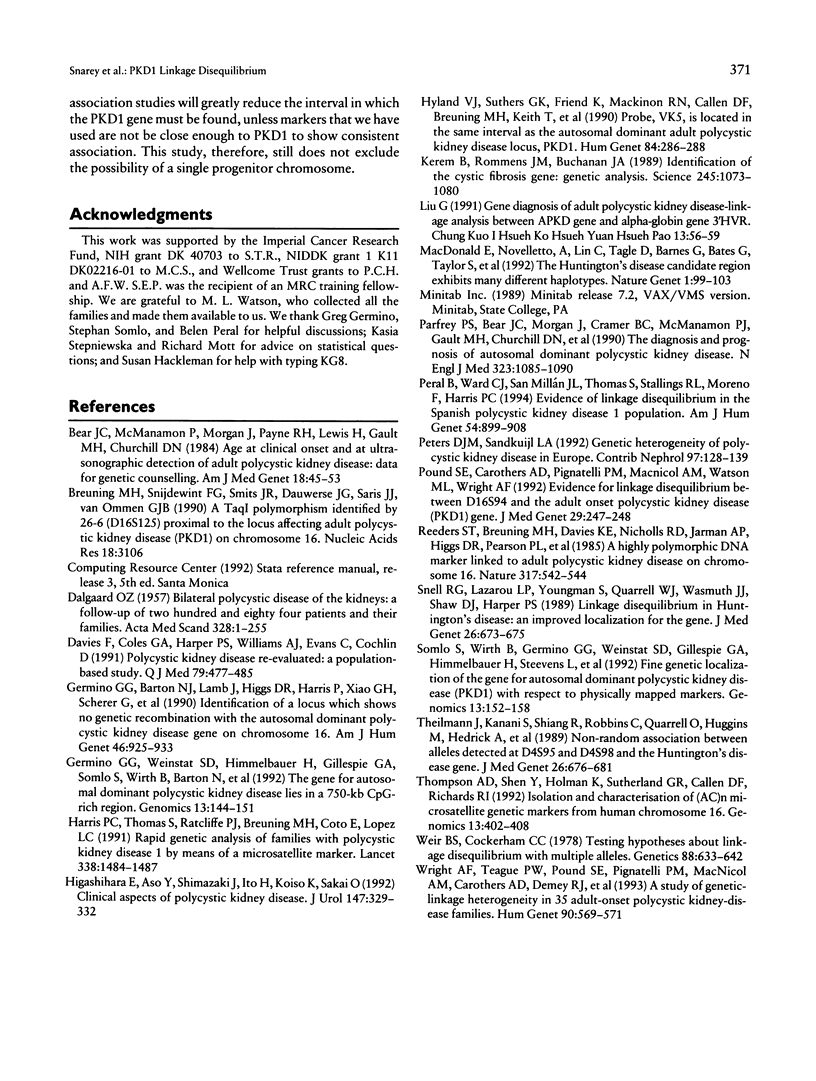
Selected References
These references are in PubMed. This may not be the complete list of references from this article.
- Bear J. C., McManamon P., Morgan J., Payne R. H., Lewis H., Gault M. H., Churchill D. N. Age at clinical onset and at ultrasonographic detection of adult polycystic kidney disease: data for genetic counselling. Am J Med Genet. 1984 May;18(1):45–53. doi: 10.1002/ajmg.1320180108. [DOI] [PubMed] [Google Scholar]
- Breuning M. H., Snijdewint F. G., Smits J. R., Dauwerse J. G., Saris J. J., van Ommen G. J. A TaqI polymorphism identified by 26-6 (D16S125) proximal to the locus affecting adult polycystic kidney disease (PKD1) on chromosome 16. Nucleic Acids Res. 1990 May 25;18(10):3106–3106. doi: 10.1093/nar/18.10.3106-a. [DOI] [PMC free article] [PubMed] [Google Scholar]
- DALGAARD O. Z. Bilateral polycystic disease of the kidneys; a follow-up of two hundred and eighty-four patients and their families. Acta Med Scand Suppl. 1957;328:1–255. [PubMed] [Google Scholar]
- Davies F., Coles G. A., Harper P. S., Williams A. J., Evans C., Cochlin D. Polycystic kidney disease re-evaluated: a population-based study. Q J Med. 1991 Jun;79(290):477–485. [PubMed] [Google Scholar]
- Germino G. G., Barton N. J., Lamb J., Higgs D. R., Harris P., Xiao G. H., Scherer G., Nakamura Y., Reeders S. T. Identification of a locus which shows no genetic recombination with the autosomal dominant polycystic kidney disease gene on chromosome 16. Am J Hum Genet. 1990 May;46(5):925–933. [PMC free article] [PubMed] [Google Scholar]
- Germino G. G., Weinstat-Saslow D., Himmelbauer H., Gillespie G. A., Somlo S., Wirth B., Barton N., Harris K. L., Frischauf A. M., Reeders S. T. The gene for autosomal dominant polycystic kidney disease lies in a 750-kb CpG-rich region. Genomics. 1992 May;13(1):144–151. doi: 10.1016/0888-7543(92)90214-d. [DOI] [PubMed] [Google Scholar]
- Harris P. C., Thomas S., Ratcliffe P. J., Breuning M. H., Coto E., Lopez-Larrea C. Rapid genetic analysis of families with polycystic kidney disease 1 by means of a microsatellite marker. Lancet. 1991 Dec 14;338(8781):1484–1487. doi: 10.1016/0140-6736(91)92300-q. [DOI] [PubMed] [Google Scholar]
- Higashihara E., Aso Y., Shimazaki J., Ito H., Koiso K., Sakai O. Clinical aspects of polycystic kidney disease. J Urol. 1992 Feb;147(2):329–332. doi: 10.1016/s0022-5347(17)37228-2. [DOI] [PubMed] [Google Scholar]
- Hyland V. J., Suthers G. K., Friend K., MacKinnon R. N., Callen D. F., Breuning M. H., Keith T., Brown V. A., Phipps P., Sutherland G. R. Probe, VK5B, is located in the same interval as the autosomal dominant adult polycystic kidney disease locus, PKD1. Hum Genet. 1990 Feb;84(3):286–288. doi: 10.1007/BF00200577. [DOI] [PubMed] [Google Scholar]
- Kerem B., Rommens J. M., Buchanan J. A., Markiewicz D., Cox T. K., Chakravarti A., Buchwald M., Tsui L. C. Identification of the cystic fibrosis gene: genetic analysis. Science. 1989 Sep 8;245(4922):1073–1080. doi: 10.1126/science.2570460. [DOI] [PubMed] [Google Scholar]
- Liu G. [Gene diagnosis of adult polycystic kidney disease--linkage analysis between APKD gene and alpha-globin gene 3'HVR]. Zhongguo Yi Xue Ke Xue Yuan Xue Bao. 1991 Feb;13(1):56–59. [PubMed] [Google Scholar]
- MacDonald M. E., Novelletto A., Lin C., Tagle D., Barnes G., Bates G., Taylor S., Allitto B., Altherr M., Myers R. The Huntington's disease candidate region exhibits many different haplotypes. Nat Genet. 1992 May;1(2):99–103. doi: 10.1038/ng0592-99. [DOI] [PubMed] [Google Scholar]
- Parfrey P. S., Bear J. C., Morgan J., Cramer B. C., McManamon P. J., Gault M. H., Churchill D. N., Singh M., Hewitt R., Somlo S. The diagnosis and prognosis of autosomal dominant polycystic kidney disease. N Engl J Med. 1990 Oct 18;323(16):1085–1090. doi: 10.1056/NEJM199010183231601. [DOI] [PubMed] [Google Scholar]
- Peral B., Ward C. J., San Millán J. L., Thomas S., Stallings R. L., Moreno F., Harris P. C. Evidence of linkage disequilibrium in the Spanish polycystic kidney disease I population. Am J Hum Genet. 1994 May;54(5):899–908. [PMC free article] [PubMed] [Google Scholar]
- Peters D. J., Sandkuijl L. A. Genetic heterogeneity of polycystic kidney disease in Europe. Contrib Nephrol. 1992;97:128–139. doi: 10.1159/000421651. [DOI] [PubMed] [Google Scholar]
- Pound S. E., Carothers A. D., Pignatelli P. M., Macnicol A. M., Watson M. L., Wright A. F. Evidence for linkage disequilibrium between D16S94 and the adult onset polycystic kidney disease (PKD1) gene. J Med Genet. 1992 Apr;29(4):247–248. doi: 10.1136/jmg.29.4.247. [DOI] [PMC free article] [PubMed] [Google Scholar]
- Reeders S. T., Breuning M. H., Davies K. E., Nicholls R. D., Jarman A. P., Higgs D. R., Pearson P. L., Weatherall D. J. A highly polymorphic DNA marker linked to adult polycystic kidney disease on chromosome 16. Nature. 1985 Oct 10;317(6037):542–544. doi: 10.1038/317542a0. [DOI] [PubMed] [Google Scholar]
- Snell R. G., Lazarou L. P., Youngman S., Quarrell O. W., Wasmuth J. J., Shaw D. J., Harper P. S. Linkage disequilibrium in Huntington's disease: an improved localisation for the gene. J Med Genet. 1989 Nov;26(11):673–675. doi: 10.1136/jmg.26.11.673. [DOI] [PMC free article] [PubMed] [Google Scholar]
- Somlo S., Wirth B., Germino G. G., Weinstat-Saslow D., Gillespie G. A., Himmelbauer H., Steevens L., Coucke P., Willems P., Bachner L. Fine genetic localization of the gene for autosomal dominant polycystic kidney disease (PKD1) with respect to physically mapped markers. Genomics. 1992 May;13(1):152–158. doi: 10.1016/0888-7543(92)90215-e. [DOI] [PubMed] [Google Scholar]
- Theilmann J., Kanani S., Shiang R., Robbins C., Quarrell O., Huggins M., Hedrick A., Weber B., Collins C., Wasmuth J. J. Non-random association between alleles detected at D4S95 and D4S98 and the Huntington's disease gene. J Med Genet. 1989 Nov;26(11):676–681. doi: 10.1136/jmg.26.11.676. [DOI] [PMC free article] [PubMed] [Google Scholar]
- Thompson A. D., Shen Y., Holman K., Sutherland G. R., Callen D. F., Richards R. I. Isolation and characterisation of (AC)n microsatellite genetic markers from human chromosome 16. Genomics. 1992 Jun;13(2):402–408. doi: 10.1016/0888-7543(92)90260-y. [DOI] [PubMed] [Google Scholar]
- Weir B. S., Cockerham C. C. Testing Hypotheses about Linkage Disequilibrium with Multiple Alleles. Genetics. 1978 Mar;88(3):633–642. doi: 10.1093/genetics/88.3.633. [DOI] [PMC free article] [PubMed] [Google Scholar]
- Wright A. F., Teague P. W., Pound S. E., Pignatelli P. M., Macnicol A. M., Carothers A. D., De Mey R. J., Allan P. L., Watson M. L. A study of genetic linkage heterogeneity in 35 adult-onset polycystic kidney disease families. Hum Genet. 1993 Jan;90(5):569–571. doi: 10.1007/BF00217461. [DOI] [PubMed] [Google Scholar]


